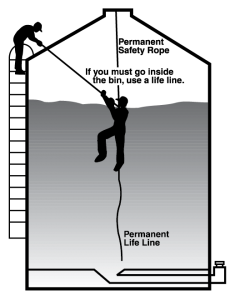If you have anyone on your team that hangs around at heights or works on confined space sites read this Companies fined $104k after worker stuck in grain silo.
Who and Where?
- New silos were being built on a farm near Gore
- Electrical company: Austin Brothers fined $35,000
- Farming company: Dillon Partnership fined $69,000
What happened?
- In March 2016, two electricians were wiring motors on top of a new silo without harnesses or power isolation.
- A truck arrived to empty the silo and when the grain outfeed auger was turned on both electricians wer engulfed in moving grain, one managed to climb out and raise the alarm
- The entrapped electrician had to be dug out and resuscitated
- Four rescuers required hospital treatment for breathing difficulties
- WorkSafeNZ chief inspector, Keith Stewart said: “it was good luck, rather than good management, that no one died.”
Why did it happen?
According to the WorksafeNZ report, Dangers of entering grain silo underestimated the following areas contributed to the incident:
- Poor risk management: Risks associated with the commissioning of the silo had not been reviewed
- Lack of emergency planning: Neither the farmer nor the electrical team had prepared or reviewed an Emergency Management Plan
- Lack of training for confined spaces: No safety officer, no communication with truck driver
- Lack of working at heights protocols: No harnesses while working on top of a grain silo.
What is a confined space?
Confined Space (as per AS 2865: 2009) An enclosed or partially enclosed space that is not intended or designed primarily for human occupancy, within which there is a risk of one or more of the following:
- An oxygen concentration outside the safe oxygen range.
- A concentration of an airborne contaminant that may cause impairment, loss of consciousness or asphyxiation.
- A concentration of a flammable airborne contaminant that may cause injury from fire or explosion.
- Engulfment in a stored free-flowing solid or a rising level of liquid that may cause suffocation or drowning.
Also refer to AS 2865: 2009 section1.5.5 notes 1-5 which provide examples of enclosed or partially-enclosed spaces that may meet the definition criteria for a confined space.
What is “Working at Heights” all about?
There is no ‘official’ legislative direction as to what working at heights means, technically any time you step of the floor you are “Working at heights”, and s 27 Health and Safety at Work (General Risk and Workplace Management) Regulations 2016 specifically refers to working with ‘Loose but enclosed materials’
In the Oil industry ‘Work at Height’ is generally deemed to be work that exceeds 1.8 metres off the ground, measured from the lowest point of the worker’s body where there is no scaffold (erected by a competent person) scissor lift, boom lift, or a permanent ladder (where the fall protection is permanently engineered into the plant or equipment).
NB: Working on top of a silo is definitely working at heights!!!
What can you do to keep your workers safe?
If there is work to be done in a confined space or at height and you are unsure of how to do it contract in suitably competent people to complete it. If you do wish to complete the work:
- Complete a Safe Work Method / Job Safety Analysis
- Make sure everyone has the correct training
- Provide the appropriate equipment
- Have a permit to work system
- Have an emergency management plan
Have a safe and productive week.
SB
